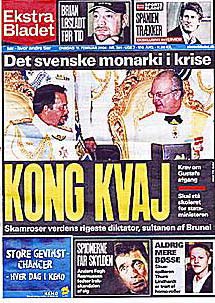
| Write On |
 |
followthemedia.com - a knowledge base for media professionals |
|
|
AGENDA
|
How to Maintain Readership LoyaltyMany European newspapers continue to suffer circulation declines but there is one solid way of not only stopping the trend but reversing it, too. Simply ask your readers what they want, and – here’s the secret of success – continually involve them in helping to decide the newspaper’s contents.All too often newspapers conduct annual readership surveys but seldom do they tell their respondents the final results, and seldom do they promise to carry through the main conclusions from the research. Little wonder that readers lose patience and circulation continues to decline. There seems to be something in the European culture that inhibits the media from asking for help from its customers. They go through the motion of surveys, but don’t make the most use of the surveys by continuing the customer contact. 
US media are more familiar with customer contact. The Associated Press news agency, for instance, has a long-established Managing Editor’s group (APME) made up of client managing editors that regularly advises the AP on what it should be doing. So powerful is the loyalty factor of this group that back in the 1980s UPI started advisory boards for its newspaper and broadcast clients, trying to instill that same brand loyalty. But Ekstra Bladet, Denmark’s largest PM circulation newspaper, has been active now for nearly three years in a Customer Relationship Management (CRM) project aimed at producing loyalty from a readership base that buys the newspaper each day rather than depending on subscriptions – some 90% of total sales are made at news stands each day. The results are encouraging and other newspapers should take note. Like many newspapers in Europe, Ekstra Bladet faced declining circulation – some 30% of those newsstands it depends on for its sales have gone out of business in the past three years. In addition, free tabloids aimed at the young and commuters are successful; readers go to the web for news, and there is constant television news available. So why buy Ekstra Bladet? The editors understood it had to be because they produced something the readers wanted, and who better to tell them what readers wanted, but the readers. As explained at the recent Direct Marketing Association annual conference, Ekstra Bladet first concentrated on its sports product. First problem was how could a newsstand-based newspaper learn who its readers were? The newspaper ran a survey and respondents were asked to mail or email responses. Some 90% responded by email and the newspaper knew that was the communication channel for the future. The respondents were told they were now members of the sports panel. They were asked what sports they were interested in, and which particular teams and then they received newsletters emphasizing those teams and sports. They also got special software allowing them to see the front page of that day’s sports section plus some news. The communications between the newspapers and the panel was frequent with respondents saying after a while in large numbers that they thought the sports section had improved although in fact there were few changes. it was obvious that reader involvement gave the reader a more positive outlook on the product. They were hooked! With the sports success it was now time to tackle the general readership. Questionnaires gave the biographies of the four main editors – a way of saying these are the people who are producing your newspaper now tell us about yourself. Those who participated get their own front page newsletter via email.. In the two experiments combined about 100,000 responses were received and there are some 46,000 active participants. The newspaper has sent some 400 emails to each participant of a 2 ½ year period. The communication continues and circulation has slightly increased. But the bottom line is that even between newspapers and its readers, CRM works. It takes a lot of effort, but at the end of the day the reader who feels involved continues to be a reader. And that is the name of the game!
|
| copyright ©2004 ftm publishing, unless otherwise noted | Contact Us • About Us |